While Elon Musk wants to found a city of a million people on Mars, his main rival in the commercial space game, Jeff Bezos, would like to revive a space colony concept first popularized by Dr. Gerard O’Neill in the 1970s, according to Alan Boyle. An O’Neill space colony consists of a giant rotating cylinder in space with people living on the inside, getting power from 24/7 sunlight. O’Neill envisioned the first such colony being established at the L5 point, one of the five Lagrange points where the gravity of the Earth and the moon cancel out. L5 has easy access to both the Earth and the moon and could serve as a way station to deep space destinations such as Mars.
The concept was actually studied by NASA at one time.
The O’Neill space colony was popularized in the movie “Interstellar” and the TV series “Babylon 5.” The idea is that humanity would not just become a multi-planet species, but would be free from planets entirely. Bezos envisions all heavy industry being moved off of the Earth, with the home planet being turned into a garden of sorts for residential and light industry.
These huge space cities would be built primarily out of extraterrestrial, from asteroids or the Earth’s moon. They could be situated anywhere or could become spacecraft, perhaps headed on centuries-long voyages to other star systems. The O’Neill space colonies would be able to build other space colonies, expanding humanity far greater than would be possible than if it were confined to a planet or even several planets.
Musk’s Mars colony represents one approach to preserving the human species, a kind of Plan B that will make sure that civilization carries on in case some catastrophe happens to Earth. Bezos’ approach is to use space colonies to preserve the Earth, by providing clean, limitless energy and a place for humans to grow and thrive.
One suspects that both approaches, the city on Mars and the free-flying space colony, are likely to be dreams given form. Both Musk and Bezos, though they are bitter rivals, grew up with the Apollo program to land a man on the moon and the “Star Trek” TV series. The dreams of the past thus inspire the dreams of the future.

